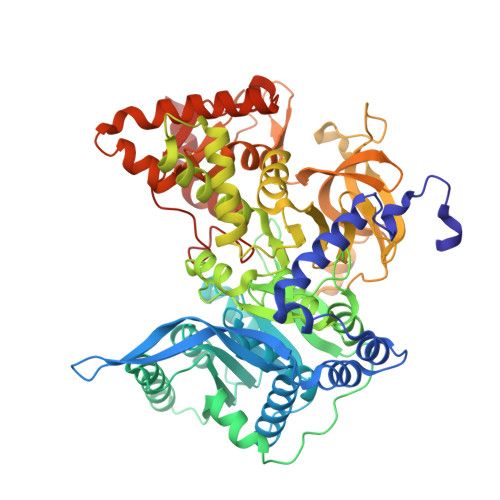One-Pot Biocatalytic Transformation of Adipic Acid to 6-Aminocaproic Acid and 1,6-Hexamethylenediamine Using Carboxylic Acid Reductases and Transaminases.
Fedorchuk, T.P., Khusnutdinova, A.N., Evdokimova, E., Flick, R., Di Leo, R., Stogios, P., Savchenko, A., Yakunin, A.F.(2020) J Am Chem Soc 142: 1038-1048
- PubMed: 31886667
- DOI: https://doi.org/10.1021/jacs.9b11761
- Primary Citation of Related Structures:
6OZ1 - PubMed Abstract:
Production of platform chemicals from renewable feedstocks is becoming increasingly important due to concerns on environmental contamination, climate change, and depletion of fossil fuels. Adipic acid (AA), 6-aminocaproic acid (6-ACA) and 1,6-hexamethylenediamine (HMD) are key precursors for nylon synthesis, which are currently produced primarily from petroleum-based feedstocks. In recent years, the biosynthesis of adipic acid from renewable feedstocks has been demonstrated using both bacterial and yeast cells. Here we report the biocatalytic conversion/transformation of AA to 6-ACA and HMD by carboxylic acid reductases (CARs) and transaminases (TAs), which involves two rounds (cascades) of reduction/amination reactions (AA → 6-ACA → HMD). Using purified wild type CARs and TAs supplemented with cofactor regenerating systems for ATP, NADPH, and amine donor, we established a one-pot enzyme cascade catalyzing up to 95% conversion of AA to 6-ACA. To increase the cascade activity for the transformation of 6-ACA to HMD, we determined the crystal structure of the CAR substrate-binding domain in complex with AMP and succinate and engineered three mutant CARs with enhanced activity against 6-ACA. In combination with TAs, the CAR L342E protein showed 50-75% conversion of 6-ACA to HMD. For the transformation of AA to HMD (via 6-ACA), the wild type CAR was combined with the L342E variant and two different TAs resulting in up to 30% conversion to HMD and 70% to 6-ACA. Our results highlight the suitability of CARs and TAs for several rounds of reduction/amination reactions in one-pot cascade systems and their potential for the biobased synthesis of terminal amines.
Organizational Affiliation:
Department of Chemical Engineering and Applied Chemistry , University of Toronto , Toronto , Ontario M5S 3E5 , Canada.


















